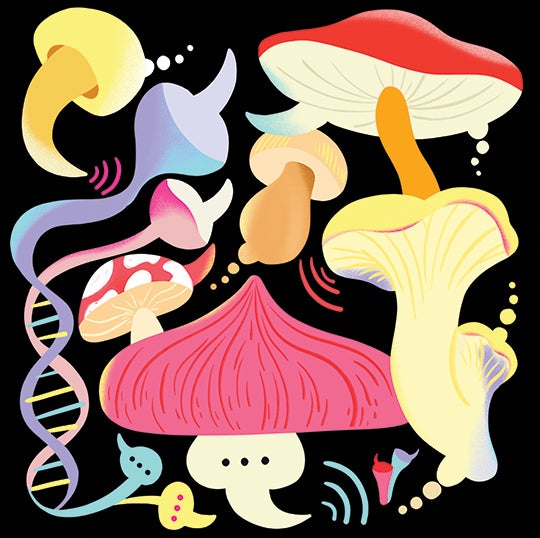How Fungi Spill Their Secrets
A high-efficiency gene-editing tool may speed up the pace of new drug discovery.

Spring 2023
By Silvia Cernea Clark
As anyone who has ever attended a cocktail party can tell you, shedding inhibitions makes you more talkative and possibly more prone to divulging secrets.
Fungi, it turns out, are no different from humans in this respect.
Using an approach that simultaneously modifies multiple sites in fungal genomes, biomolecular engineer Xue “Sherry” Gao and her collaborators coax fungi into revealing their best-kept secrets, potentially ramping up the pace of new drug discovery. It is the first time that the technique, called multiplex base editing (MBE), has been used as a tool for mining fungal genomes for medically useful compounds (think: penicillin). Compared to single-gene editing, MBE reduces the research timeline by over 80% in equivalent experimental settings, from an estimated three months to roughly two weeks.
To me, the fungal genome is a treasure.
Base editing refers to the use of CRISPR-based gene editing tools in order to modify a rung in the spiral ladder of DNA known as a base pair. Previously, gene modifications using base editing had to be carried out one at a time, making the research process more time-consuming. “We created a new machinery that enables base editing to work on multiple genomic sites, hence the ‘multiplex,’” Gao said.
Using MBE, the Gao lab induced fungi to produce significantly more natural compounds, including some previously unknown to the scientific community. “To me, the fungal genome is a treasure,” Gao said, referring to the significant medical potential of fungi-derived compounds.
“However, under most circumstances, fungi ‘keep to themselves’ in the laboratory and don’t produce the bioactive small molecules we are looking for.” Enabled by MBE, her team can easily delete several of the regulatory genes that “make the biosynthetic machinery silent.” Disinhibited, the engineered fungal strains produce more bioactive molecules, each with their own distinct chemical profiles. “These compounds could be useful antibiotics or anticancer drugs,” Gao said.
Xue “Sherry” Gao is the Ted N. Law Assistant Professor of Chemical and Biomolecular Engineering and an assistant professor of bioengineering and chemistry. The study was published in the Journal of the American Chemical Society.
